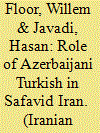|
|
|
Sort Order |
|
|
|
Items / Page
|
|
|
|
|
|
|
| Srl | Item |
| 1 |
ID:
165776


|
|
|
|
|
| Summary/Abstract |
There have been a number of important efforts to map out the languages of Iran, but until now no language atlas, or even a comprehensive and detailed country-level language map, has been produced. One of the recent initiatives which aims to fill this gap is the online Atlas of the Languages of Iran (ALI) (http://iranatlas.net). This article delineates objectives of the ALI research programme, atlas architecture, research methodology, and preliminary results that have been generated. Specific topics of interest are the structure and content of the linguistic data questionnaire; the handling of contrasting perspectives about the status of “languages” and “dialects” through a flexible multi-dimensional classification web; and the role of ongoing comparisons between language distribution assessments and hard linguistic data.
|
|
|
|
|
|
|
|
|
|
|
|
|
|
|
|
| 2 |
ID:
179401


|
|
|
|
|
| Summary/Abstract |
Most studies on language contact in Iran have focused on the effects of Persian on the country’s minority languages. There are also many cases where large regional languages such as Azeri, Kurdish, Balochi, Lori and Bakhtiari exert an influence on smaller regional languages, and a few studies have appeared on this topic. This paper examines the effects of language contact in the city of Juneqan in Chahar Mahal va Bakhtiari Province, Iran, where the position of two minority languages—Bakhtiari and Qashqai Turkic—appears to be evenly balanced. The analysis is based on a comparison of L1 and L2 speech from two bilingual individuals with a different L1, as found in responses to the Atlas of the Languages of Iran (ALI) questionnaire. Drawing on examples from lexicon, phonology and morphosyntax, the article argues that the equivalent influence of each language on the first- and second-language speech of members of the other language community is likely achieved not by simple equal status, but through the counterbalancing of regional Bakhtiari dominance with majority mother-tongue Turkic population in this city.
|
|
|
|
|
|
|
|
|
|
|
|
|
|
|
|
| 3 |
ID:
128569


|
|
|
|
|
| Publication |
2013.
|
| Summary/Abstract |
Turkic languages and dialects played a much more important role in Safavid Iran than is generally thought, while Azerbaijani Turkish in particular was widely spoken and written in Safavid Iran. It was not only the language of the court and the army, but it was also used in poetry, even by renowned poets who usually wrote in Persian. The Safavid shahs, many of whom wrote poetry in Turkish themselves, promoted its literary use. Also, Turkish was used in the court's official correspondence, for both internal and external affairs.
|
|
|
|
|
|
|
|
|
|
|
|
|
|
|
|
| 4 |
ID:
192970


|
|
|
|
|
| Summary/Abstract |
The study of language and script change among the Turkic communities of the Soviet Union often focuses on the switch from Arabic to Latin scripts. Less attention is paid to adaptations of the Arabic script to Turkic vernaculars, and to attempts aimed at convincing the literate masses of their usefulness. In the current paper, I aim to do just that. By making use of Turkic-language periodicals from Crimea, Azerbaijan and Uzbekistan, I throw light on the era before Latin. I explore writers’, editors’ and other intellectuals’ efforts to vernacularize written languages and enforce national boundaries along Soviet lines through changes to the dominant script. More than this, I investigate these actors’ use of magazines to convince their readers of new vernacular, language- and territory-based national identities. In doing so, I demonstrate that periodicals became implements of national consciousness creation targeted at the Turkic citizens of the early Soviet Union.
|
|
|
|
|
|
|
|
|
|
|
|
|
|
|
|
|
|
|
|
|